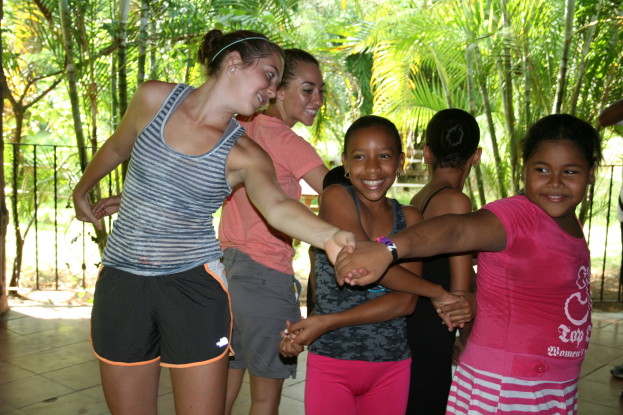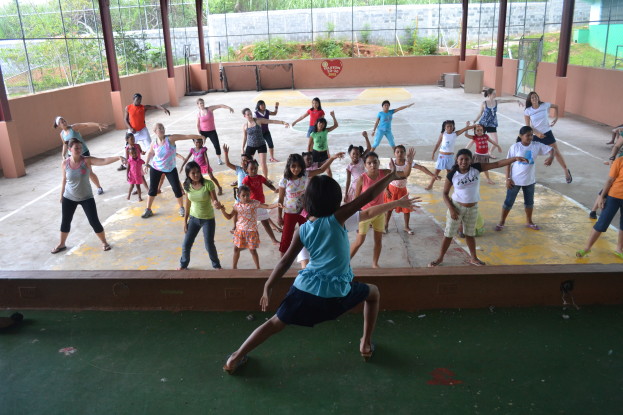MOVEMENT EXCHANGE is a San Francisco based non-profit that organizes service-focused dance exchanges to Panama with the objective of using dance and dance education as a tool for creating sustainable social change, both in the countries where the exchanges occur, and here at home.
This, I am a little bit ashamed to say, does not fit my mental model of what a dancer does. Even after knowing dancers who lived every kind of life imaginable under the mantle of “dancer,” as a dance enthusiast, my go-to mental model of a dancer is still of a tightly- wound bundle of energy, hurtling across a sprung floor with equal parts, grace and passion. Sometime this is as a singular being, sometime in unison, but always as a performer, and if not a performer, then as a teacher to performers. I needed to find out more about the model being developed by Movement Exchange, so I spoke with founder Anna Pasternak, whose own personal development as a dancer led to the formation of Movement Exchange.

Anna grew up in the San Francisco Bay Area and attended San Francisco’s School of the Arts, where she was active in the dance program. Like many young dancers, when she left for college, dancing as a regular practice was put on hold. Because Anna went to high-octane academic atmosphere of Harvard, that hold was somewhat more pronounced. “At Harvard you spend all your time in the library. I majored in Anthropology which was my way to get to travel a lot and do a lot of research on dance. But I didn’t have much time to pursue dance,” she tells me. “I missed dance, but I found that the parts I missed were not the performance aspects, but the community. A lot of what Movement Exchange turned into was looking for that missing piece.”
Two years after graduation, Anna was employed by a non- profit in Panama, working in indigenous communities. Needing dance to be part her life, she began teaching dance to young people in orphanages and realized “that my relationship to dance was no longer based around the desire to perform, but around creating a community around dance.” “It was seeing how the kids transformed and changed. Dance really is a connector. I knew there were lots of dancers who had this same urge, but didn’t have an outlet for it.”
Anna went looking for the dancer’s version of Doctors without Borders, and when she didn’t find it, “I went out on a whim and created it.” Movement Exchange began “without really knowing what the components would be [except for these three things]…It would be about giving back, it would be sustainable, with local dance teachers being paid to teach year-round—this wouldn’t be a program of one-hit wonders…and it would be about dancers making a difference not only in Panama, but in their own communities when they returned.”
Because she already had the connections, Anna organized the first exchange to Panama in 2010 with 13 dancers from all around the United States between the ages of 17 and 50. They were people like her. People who believe dance is a lens to learn about the cultural fabric of another country, and can also be a tool for community engagement and meaningful social change.
Anna and those 13 “dance diplomats” spent eight days working with over 100 orphans and at-risk youth who, prior to this experience, “had never had dance education, or much arts education of any kind, or contact with foreigners, or experience with this kind of instruction.” The dancers taught whatever dance forms they practiced, “whether that’s ballet or belly dancing, hip hop, tap or salsa. Whatever their strength, that is what they teach to the children.”
The process was the point, yet the dance diplomats and their students needed a space to publicly celebrate and conclude this first part of the process. “I knocked on the door of the US Embassy and asked them for support and they agreed to pay for the rental of the National Theater of Panama.” Anna recognized that US Embassy has their own agenda, but that “the people there were sincerely passionate about making a difference in the lives of at-risk youth, as well as increasing cross-cultural understanding.” The idea of dance diplomacy carried some weight.
After eight days of work, 100 kids performed on the stage of the National Theater in front of a packed audience of 500 people. According to Anna, the impact was significant in the surrounding community for many reasons, not least of which was that “it was a free performance so it was attended by people who live in the neighborhood who don’t normally have access to their own theater because they can’t afford it.”
By the time the kids went on stage, the show had grown to include guests. The University of Panama’s dance company along with local dance companies performed and the dance diplomats choreographed their own piece. The children performed, and then watched the performances of the other companies.
For the kids, Anna saw two main benefits: “they got to perform and feel that sense of self-worth that they did something valuable and people came to the theater to see them…but they also sat in the wings watching these dance companies perform and were part of this dance community behind the scenes.”
Despite being physically and mentally exhausted after the first exchange, Anna knew it had to happen again. “It solidified my desire to build a movement behind this, because no one is doing this. No one is creating this avenue for dancers to give back in this constant, sustainable way.”
A key turning point in the growth of Movement Exchange came when Anna met up with fellow dancer Mei-Ling Murray back in San Francisco. Mei-Ling also grew up in the Bay Area and was a “classic bun-head” from the age of 6. A fervent student of ballet throughout her youth, she majored in Dance at the University of Arizona. While in school she studied abroad in Ghana where her understanding of what being a dancer means was transformed.
For Mei-Ling, dance “changed from performance art to cultural language. I was able to identify with so many amazing people in Ghana because of my dance background— it was like this colloquial invitation. So after college I had subsequent travels, and without even thinking about it, the method I took to immersing myself in a culture was to ask, ‘I’m a dancer, where are the other dancers? Let’s hang out!”
Despite attending a “wonderful dance program that was training me to become a really good dancer,” Mei-Ling felt somewhat disappointed on her return from Ghana because “there was nothing in that education about getting involved with community, about doing some outreach. Every single hour was spent on physical and technical training.”
With Mei-Ling’s aide, the program’s three components, which were the only things Anna was certain about at the beginning, have become the pillars Movement Exchange has been built on: Service, Sustainability and Exchange/Education. In the program, a dancer (and it can be any dancer, of any skill level) signs up for an exchange to become a dance diplomat and teach dance to orphans and at-risk youth in Panama as well as explore Panamanian culture. The fees dance diplomats pay for the exchange covers living expenses for the eight days they spend in country, but also pays for local instructors to continue teaching dance to the youth after the exchange has ended, so the dance instruction continues year round. For Dance Diplomats the exchange ends, but the concept of dance as an effective vehicle for creating social change is something they carry with them when they return to the United States.
Mei-Ling describes it as “empowerment on all fronts. The people who participate are empowered because they experience another country through the lens of dance. The children are empowered because they received the dance training, and they receive the connection and love and acknowledgement. The local instructors who Movement Exchange supports are empowered to use their skills to benefit their communities. And all components circle around to support each other.”
Although Movement Exchange holds regular open calls to organize exchanges with anyone who wants to attend, their biggest success, and the one they believe will be key to helping them scale up the model they’ve piloted in Panama, is the formation of Movement Exchange clubs on university campuses. Indiana University and the University of Utah both have very active chapters of Movement Exchange. Anna explains to me that “the model is to find amazing leaders in colleges and high schools and creating groups that change people’s relationship to dance, especially people who are going to become dancers after college. This is a way to remain engaged with dance… beyond going to your weekly modern/ ballet/jazz class.”
The experience with Movement Exchange may be the catalyst that changes their relationship to dance, but for Anna, “whether or not they continue with dance is less the point than whether or not the seed has been planted to be [a] life-long volunteer and civically engaged person.”

Movement Exchange forms the passion for service and dance with their dance diplomats while they are abroad so they continue that service here. “When they return we try to put them in touch with fantastic groups doing work here in the States to see if there’s a way they can help through dance.” One example Anna gives me is how Indiana University’s Movement Exchange club holds weekly dance classes for local chapters of the Boys and Girls Club and Girls Inc.
In the future Movement Exchange is planning to organize exchanges to India, and possibly Brazil, as well as continuing exchanges with their partners in Panama. Anna hopes to build a curriculum through this process, on cross-cultural exchange through dance. They are also going through the process of becoming a sustainable organization with the various logistical and administrative improvements, and most importantly, securing funding for the work to continue.
“Our focus has been making the program take off, excelling the program, expanding it,” Mei-ling tells me, “and now we have to focus a little bit on the operations side-by-side with the expansion.” Anna and Mei-Ling have been building a leadership team, making presentations to potential funders and will begin an Indiegogo campaign in March.
Towards the end of the conversation, I returned to my question of what it means to be a dancer, and said something to the effect that what they are doing is contrary to an image of dancers as a performing artist. Mei-ling disagrees with me, “What we’re doing isn’t in defense. We aren’t saying what performing artists do isn’t valuable, because it is immensely valuable. This is something different. Perhaps it’s because we’re from the Bay Area and had a socially conscious upbringing.”
Anna agrees, adding, “the question is how do you make the world a better place? If you’re a dancer, this is one way of doing that.”
This article appeared in the March 2014 issue of In Dance.

